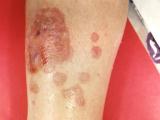A large meta-analysis of observational studies that provided the basis for the recent makeover of global recommendations for multidrug-resistant tuberculosis (MDR-TB) treatment shows that newer and repurposed drugs produced better outcomes and fewer deaths than older treatments.
The meta-analysis of 50 studies involving 12,000 patients from 25 countries, published yesterday in The Lancet, found that bedaquiline, linezolid, levofloxacin, and moxifloxacin were associated with greater treatment success and reduced mortality compared with the previously recommended first-line treatments, while clofazimine and carbapenem antibiotics were associated with significantly improved treatment outcomes (but not reduced mortality).
Bedaquiline and linezolid were also associated with better outcomes and reduced mortality in patients with extensively drug-resistant (XDR)-TB.
Two of the drugs that have been the stalwarts of the previous treatment regimen, the injectable antibiotics kanamycin and capreomycin, were associated with significantly worse outcomes. Other drugs used to treat MDR-TB, including pyrazinamide, amikacin, ethionamide/prothionamide, and para-aminosalicylic acid, were associated with modest or no benefits.
The team of researchers that led the study—the Collaborative Group for the Meta-Analysis of Individual Patient Data in MDR-TB Treatment 2017—suggests that the increasing use of the newer and repurposed drugs could explain the higher success rate for MDR-TB treatment found in their analysis than in previous studies. The success rate found in the meta-analysis was 65%, compared with the 54% success rate cited in the World Health Organization's (WHO's) 2017 global tuberculosis report. But to date these drugs have been used on only a limited basis because of a lack of data on their effectiveness.
"Our findings support immediate efforts to enhance access to these drugs, which is currently limited, despite WHO guidelines recommending wider use," the authors write.
Aiming to improve treatment success
Those efforts are already under way. With these findings and data from other recent studies in hand, the WHO in August released new treatment recommendations for MDR-TB that prioritize newer medications and oral medications over injectable drugs.
Bedaquiline, linezolid, and levoxacin/moxifloxacin are now in the top category (Group A) of recommended treatments. Kanamycin and capreomycin, which have been associated with serious side effects such as hearing loss and kidney failure, are no longer recommended.
The WHO says a more detailed version of the new guidelines will be released at the end of the year, but the agency is urging national TB programs to start preparing for the changes now. Making headway against forms of the disease that are resistant to the front-line TB drugs rifampicin and isoniazid is a major priority for the agency, which aims to reduce TB deaths by 95% by 2035. According to the WHO's estimates, roughly 600,000 cases of MDR-TB emerge each year, and 240,000 MDR-TB patients die.
The low success rate of the previous MDR-TB treatment regimen is attributed in part to its length (18 to 20 months) and to less effective, more toxic second-line drugs.
Value of drug susceptibility testing
In the meta-analysis of 50 studies published from 2009 through April 2016, which also included individual-level patient data, the researchers assessed end-of-treatment success (defined as cure or completion) in MDR-TB patients compared with failure or relapse, and death from any cause during treatment. They then analyzed the association of each drug with success and death. For the analysis of each drug, patients were included if they received at least 1 month of the drug.
The overall pooled success rate for MDR-TB treatment in 12,030 patients was 65%, and the failure rate was 6%. Eleven percent of patients died during treatment, and 12% did not complete treatment.
Compared with failure or relapse, treatment success was positively associated with the use of linezolid (adjusted risk difference, 0.15), levofloxacin (0.15), carbapenems (0.14), moxifloxacin (0.11), bedaquiline (0.11), and clofazimine (0.06). In addition, there was a significant association between reduced mortality and use of linezolid (-0.20), bedaquiline (-0.14), moxifloxacin (-0.07), and levofloxacin (-0.06).
Compared with regimens without any injectable drug, the use of kanamycin was associated with significantly lower success (-0.07) but no difference in death (0.01), while use of capreomycin was associated with lower success (-0.03) and more deaths (0.04).
The meta-analysis also found that treatment outcomes were significantly worse for most drugs in patients with isolates that showed in vitro resistance to those drugs. "This finding emphasizes the value of drug susceptibility test results to guide regimen selection, and the urgent need for expansion of laboratory capacity to perform these drug susceptibility tests," the authors write.
The authors also say the findings, which are limited by the observational design of the study, highlight the need to conduct randomized trials to determine the most favorable combinations and durations of MDR-TB drugs.
See also:
Sep 6 Lancet study
Aug 20 CIDRAP News story "WHO revises MDR-TB treatment with focus on oral drugs"
























